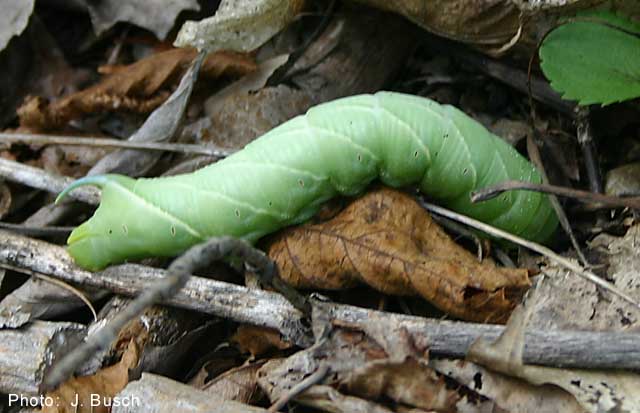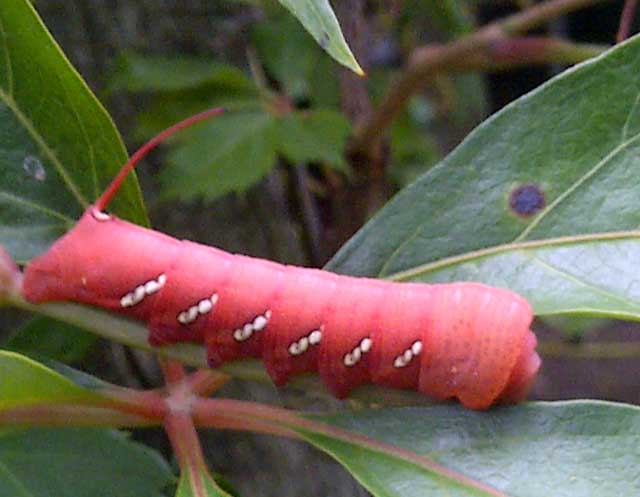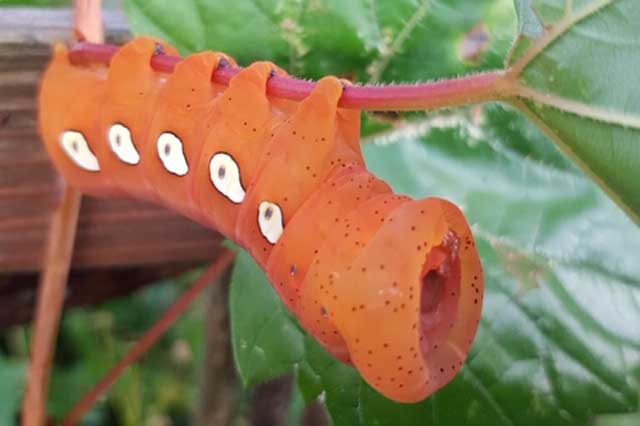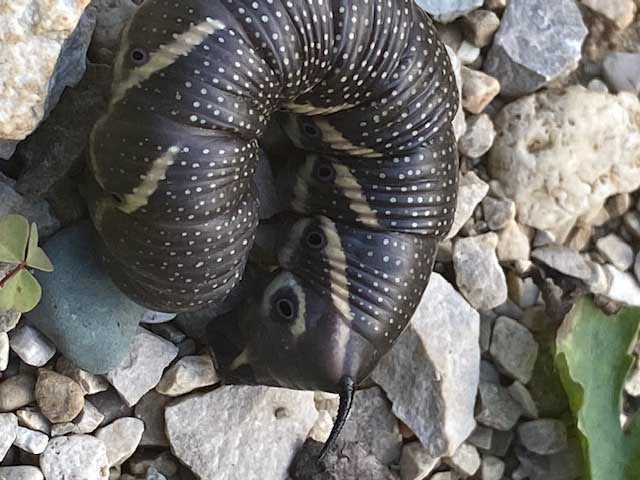Sphinginae subfamily
Sphingini tribe:
 |
Ceratomia amyntor
common,
the Elm Sphinx or Four-horned Sphinx:
Larvae feed on Elm (Ulmus), birch (Betula), basswood
(Tilia), and cherry (Prunus).
There are both green and brown forms. The four horns near
the head are diagnostic. |
 |
Ceratomia catalpae
maybe,
Catalpa Sphinx: Young caterpillars feed gregariously on Catalpa species
(Catalpa bignoniodes and C. speciosa) in
Bignoniaceae family, skeletonizing foliage.
Larvae are mostly white in early instars.
generally more southerly species |
 |
Ceratomia undulosa
common, Waved Sphinx:
Fraxinus, Ligustrum, Quercus, Crataegus and
Chionanthus virginicus are listed as hosts.
In the fifth instar, the spiracular ovals are decidedly red and the
anal horn is off-white to pinkish laterally.
|
 |
Dolba hyloeus
present, Pawpaw Sphinx:
Pawpaw (Asimina triloba), littleleaf sweetfern
(Myrica aspleniifolia), possum haw (Ilex decidua),
inkberry (Ilex glabra) Tall Gallberry Holly
(Ilex coriacea). Ilex verticellata in Quebec.
|
 |
If you have pines, you probably have this species. It flies on P.E.I.
|
 |
Lintneria eremitus
present, the
Hermit Sphinx: The upperside of the forewing is gray-brown with wavy lines, black
dashes, and one or two small white spots near the center of the costa.
|
 |
Manduca quinquemaculatus
common,
Five-spotted Hawkmoth:
Tomato Hornworms: Black horn at end of abdomen.
Larvae feed on potato, tobacco, tomato, and other plants in
nightshade family (Solanaceae).
|
 |
Manduca sexta
JPB, Carolina Sphinx:
Note the red horn and black dots anterior to the white oblique lines.
If you grow tomatoes, you have probably encountered it.
occasionally encountered in southern Ontario
|
Manduca sexta, London, Ontario, September 1, 2008, Jack P. Brooks.
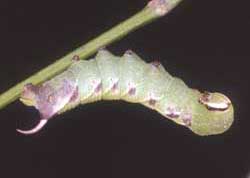
|
Sphinx canadensis
present,
Sphinx canadensis, Canadian Sphinx, uncommon, not
often reported anywhere,
present; reported from
southern Ontario. I believe they are present in Nova Scotia.
Larval hosts: white ash (Fraxinus americana), blueberry
(Vaccinium).
|
 |
Sphinx chersis
abundant, Northern Ash Sphinx;
Great Ash Sphinx: present, common.
Larval hosts are ash, lilac, privet, cherry, and quaking
aspen. Note pale blue horn.
|
Sphinx chersis fifth instar, Ottawa, Ontario,
August 1, 2010, courtesy of Don Chartrand.
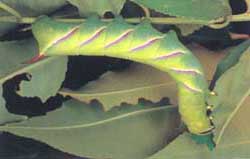 |
Sphinx drupiferarum
abundant,
Wild Cherry Sphinx:
This species is officially reported in Ontario. We have them
on P.E.I., but I do not see them nearly as frequently
as I see the other Sphingidae.
|
 |
Sphinx gordius,
Apple Sphinx:
Fw upperside: brown with black borders
through brownish gray with paler borders to pale gray with no
borders. It is probably Sphinx poecila that
is present in Ontario. |
 |
Sphinx kalmiae
present, Laurel Sphinx:
Lower forewings: predominantly brownish-yellow with fairly
wide dark bar along inner margin. Wings hug body,
giving moth long slender look. Anal horn: blue with extensive black markings in final instar.
|
Sphinx kalmiae fifth instar, Marmora, Ontario, late July 2009, Damian MacSeáin.
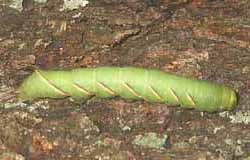 |
Sphinx luscitiosa
present,
Canadian Sphinx;
Clemen's Sphinx:
This one is reported from Ontario, but it is generally not common.
|
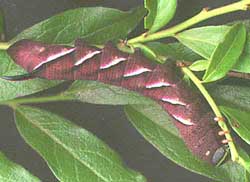 |
Sphinx poecila
abundant, Poecila Sphinx:
If you have blueberries in the woods, then you might have the
Poecila Sphinx.
They are pretty common here on Prince Edward Island. Larvae
can be purple or green.
|
Smerinthini Tribe:
 |
Amorpha juglandis
FS/ML/ USGS,
Walnut Sphinx:
Larvae feed upon Walnut,d butternut (Juglans),
hickory (Carya), alder (Alnus), beech (Fagus),
hazelnut (Corylus), hop-hornbeam (Ostrya). |
 |
Pachysphinx modesta
USGS,
the Modest Sphinx or Poplar Sphinx
Larvae feed on poplars and cottonwood.
|
 |
Larvae accept willows, birches, and cherries.
I have also found them in the wild on oak in eastern Canada. generally more eastern species |
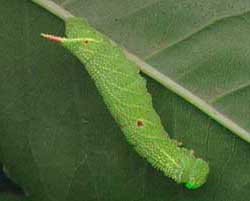 |
Paonias myops present, Small-eyed Sphinx:
Named for small eye-spot in hindwing, this moth has wide
distribution; probably common in Ontario.
I regularly see them on Prince Edward Island, and they are reported
as far south as Florida.
|
 |
Smerinthus cerisyi
common,
Cerisyi's Sphinx:
found in southern regions of all Canadian
provinces and in northern border states. One-eyed sphinx is also
found in US eastward of Continental Divide. Common on P.E.I..
|
 |
Smerinthus jamaicensis
present,
Twin-spotted Sphinx:
Larvae feed upon many forest trees including birches and cherries,
but are expecially fond of poplars and willows. Red markings on sides
vary greatly from specimen to specimen.
|
Macroglossinae subfamily
Dilophonotini tribe:
See Hemaris comparison to help distinguish
the next three species.
 |
Hemaris thysbe
common, Hummingbird Clearwing:
Also an orangey-pink prepupal form. Lateral line runs
from S1 to the blue horn.
Hemaris thysbe larvae feed on viburnum and related plants.
generally more eastern species
|
 |
Hemaris diffinis
common,
Snowberry Clearwing or Bumblebee Moth:
Snowberry (Symphoricarpos),
honeysuckle (Lonicera), Coralberry, viburnums, Blue Dogbane
(Apocynum) dwarf bush honeysuckle (Diervilla lonicera).
Horn: black with yellow base.
|
 |
Hemaris gracilis
present, the
Slender Clearwing or Graceful Clearwing
This day-flying moth is less common.
|
Philampelini tribe:
 |
Eumorpha achemon
present,
Achemon Sphinx:
Grape (Vitis), Virginia Creeper
(Parthenocissus quinquefolia) ather vines/ivies
(Ampelopsis).
Mature larvae occur in many colours: light green; tan/brown; orangey. Note six "segmented" oblique lines.
Immatures are often pinkish-red
with long, curved anal horns.
|
Eumorpha achemon fourth instar, Windham Centre, Norfolk County, July 27, 2011, Lynda Amorim
 |
Eumorpha pandorus
common, Pandorus Sphinx:
If you have Grape or Virginia Creeper nearby, then you might encounter
this species. Note five large white ovals. Orangey-brown and green
forms.
|
Eumorpha pandorus fifth instars on Engelmans's Ivy, August 1, 2011, Kingston, Gayle Beauregard.
Eumorpha pandorus green fifth instar, Mississauga, Peel Region, August 21, 2014, Caymen Vieira.
Macroglossini tribe:
 |
Amphion floridensis
common,
Nessus Sphinix:
Virginia creeper; Grape (Vitis),
ampelopsis (Ampelopsis), cayenne pepper (Capsicum).
Larvae are green until final instar.
|
 |
Darapsa choerilus
common, Azalea Sphinx:
Azalea, Viburnum; rapid growth.
Larva to left on Viburnum cassinoides is getting ready to
pupate. Color change from green to light burgundy-brown indicates
pupation is imminent. |
 |
Darapsa myron common, Virginia Creeper Sphinx; Grapevine Sphinx:
If you have the
foodplants indicated in common names, you probably have this
species nearby. Lwer wings: orange.
Virginia creeper (Parthenocissus quinquefolia),
Grape (Vitis), Ampelopsis, Viburnum. |
 |
If you have hydrangea growing near a stream, then you may have the
Hydrangea Sphinx.
|
 |
Deidamia inscriptum
common,
the Lettered Sphinx:
This species has been recorded in Ontario, and it is an early
season flier.
Larvae feed on grape foliage and on Virginia Creeper.
|
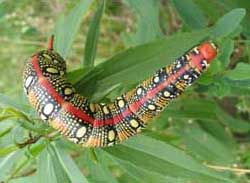 |
Hyles euphorbiae
introduced,
the Leafy Spurge Hawkmoth:
This species has been introduced into Ontario to try to control
the spread of leafy spurge.
|
 |
Hyles gallii
present, the Bedstraw Hawk Moth
or Gallium Sphinx:
This species is reported in Ontario.
Some years I see them on P.E.I., some years, I do not.
Larvae can be quite variable.
|
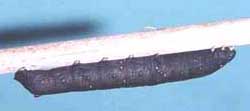 |
Proserpinus flavofasciata
present,
the Yellow-banded Day Sphinx:
This day flier is officially reported from Ontario, but it
maynot be common. Look for them in meadows near coniferous forests.
|
 |
Sphecodina abbottii
common,
the Abbott's Sphinx:
Larvae feed at night on grape (Vitis) and ampelopsis
(Ampelopsis) and hide on the bark of their host plants during
the day. Virginia creeper would also be a suitable host. There is also a dark form
without the green patches. Note the "raised eye", replacing the anal
horn.
|
Sphecodina abbottii (dark form) larva, Kenora, July 18, 2014, Irma and Greg Gerhmann
Sphecodina abbottii (green blotch form) larva, Muskoka, August 1, 2014, Emilie Shaw
|
|
